Part VII:
Films Co-directed by Edwin Stanton Porter & Wallace McCutcheon
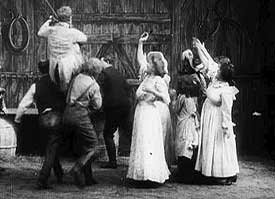 Edwin S. Porter made several films together with Wallac McCutcheon, all before May 1907. These had a considerable range of content, from melodramas to comedies to fantasies & crime tales. Some were superb, some were mediocre.
Edwin S. Porter made several films together with Wallac McCutcheon, all before May 1907. These had a considerable range of content, from melodramas to comedies to fantasies & crime tales. Some were superb, some were mediocre.
They included some of the most popular films between 1905 & 1907, but by 1908 critics would turn on Porter as directors with more sophisticated editing & storytelling technique began to surface.
The faults built into Porter's technique, learned through those years when films had to be told in two or three minute bites with each chapter shown inside its own kinetoscope, were not quite the same requirements of the projected nickelodian experience, when stories could be longer, though still only about a thousand feet per "feature" which amounted to ten or fourteen minutes, what would soon be known as "one reelers."
Porter could construct films to make sense forward or backward or with whole segments missing, which was superb for kinetoscopes which might be viewed out of order or some exhibitors might not even carry the entire set. But as one-reelers they needed a more dynamic forward narration. Sometimes Porter did that fine, but it wasn't as natural to him.
A melodrama of a woman's ruin & salvation, The Miller's Daughter (1905) does not survive in its entirety, but does not seem to be missing much because of Porter's synoptic method of creating two or three minute scenes complete in themselves.
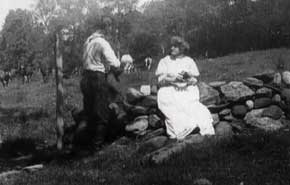 That's not to say it's always easy to follow. It's a thirteen minute condensation of a stage melodrama, Hazel Kirke (1880), a sufficiently well known play that anyone who viewed the film adaptation would know the protagonist's name was Hazel. That's not to say it's always easy to follow. It's a thirteen minute condensation of a stage melodrama, Hazel Kirke (1880), a sufficiently well known play that anyone who viewed the film adaptation would know the protagonist's name was Hazel.
This rather than the two missing scenes weakens the film, & was an element of some of Porter's films that critics in time would cease to overlook.
Hazel the miller's daughter, assaulted by a tramp, is saved by a chivalrous artist who happened by the same lake path. Hazel is loved by a good man, an honest farmer, but he's unexciting. Having been saved like a fate worse than death by the passing artist, she thinks only of him.
She becomes the artist's model & invites him to a ho-down, a riotous event for bumpkins intended to lend action & motion to the film though lending blessed little to story momentum.
Their relationship develops, against her father's wishes, & to the sorrow of the honest farmer. But it comes to a humiliating conclusion when she runs off with him only to discover the artist secretly has a wife & child. When she attempts to return home, her father has disowned her, & refuses to have her in the house.
The film at this point has missing footage. A contemporary catalog discription informs us the miller's daughter was soon living in penury taking in piecework in her poor lodgings. But she has made so little money that she cannot even make the payment on the sewing machine, which is repossessed.
Even without this footage, the film picks up reasonably enough, jumping from Hazel being turned out by her father, to her ruined state wandering homeless in the cold streets in a tattered shawl, the very figure of doom.
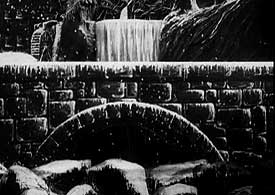 Weak from hunger, she nearly collapses, & has a vision of her father, or a memory of him, in what amounts to a "thought balloon," a trick to convey a character's interior life that Porter first used in The Life of an American Fireman (1903). Weak from hunger, she nearly collapses, & has a vision of her father, or a memory of him, in what amounts to a "thought balloon," a trick to convey a character's interior life that Porter first used in The Life of an American Fireman (1903).
We next see her in winter, standing on a bridge, a waterfall at the back, a beautiful setting, except that Hazel is in despaire & leaps into the frozen waters below intending to die.
A missing scene preceeded this, but once again the film makes sense without it due to Porter's synoptic storytelling method.
Her leap from the beautiful waterfall is wonderfully dramatic, but in no way lingering or overdone, a superior moment in the film. By the luckiest coincidence, who should see her but the farmer who had always loved her. He leaps from the bridge to save her.
Leaping to two years later (& no, there's no missing scene to bridge the time shift), we see that Hazel is the farmer's wife & they now have a child. The miller who cast out his daughter has gone blind in his old age, but healthy, & has forgiven his daughter & is himself happy to be a grampa.
This film has greater realism than most melodramas up to this time. With a few small lapses, it has surprisingly naturalistic acting. The suicide attempt is matter of fact without excesses, wich makes it more alarming. The happy ending is forced & quick, but de rigour for films of the time.
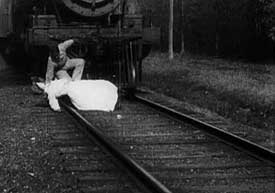 Yet another melodrama for Porter & McCutcheon is The Train Wreckers (1905). It opens on a nice suburban home, a dog on the porch, & a young woman coming out of the house & gazing down the road expectantly.
Yet another melodrama for Porter & McCutcheon is The Train Wreckers (1905). It opens on a nice suburban home, a dog on the porch, & a young woman coming out of the house & gazing down the road expectantly.
A man passes by with a lunchbox, greeting the young woman & petting her dog. He's the train engineer, with whom a romance is budding.
She's the switchman's daughter & in the following scene has come to the train yard to bring her father's lunch.
On her way home through the woods, she encounters & attempts to hide from a group of men, outlaw tramps who for no reason given seek to cause chaos along train tracks. The lack of motivation has been interpretted by modern film historians as indicating a rift between outcasts & society, with these men wanting to wreck trains with no motive beyond rebellion.
But viewers of the era would've known that many towns fought horrific battles over placement of tracks, as the future survival of many communities hinged on having rail access to cattle markets, for example. So even without giving these "train wreckers" a specific motivation, it was not difficult to recognize them as a specific type of hired thug.
They capture the girl, bind her to a tree, stuff a cloth in her mouth, leaving her there as they set for the tracks to stack logs in the way of the next train. The girl's dog finds her, chews the rope, freeing her from the tree.
She hurries to the train tracks & sees the logs in the way of the train. As they're too heavy for her to move, she takes off a half-slip from under her dress to use as a white flag to stop the train, saving the day.
But in this precursor to the Perils of Pauline, worse is yet to come. The train-wreck gang attack her again on the way home, knocking her unconscious & laying her across the tracks. The next train will take off her head & her arm.
The train is coming! One of the engineers is the man she loves. He climbs down on the cow-catcher & as the train approaches the unconscioius girl's form, she turns into a lightweight department store dummy which he scoops up with ease in one bare hand.
The train-wreck gang has meanwhile stolen a hand-pump cart & are riding away from the area on the tracks. The engineers unhook their train cars & take off at full tilt in the locomotive to catch up with wreckers.
There's a shoot-out from train engine to pump-cart between engineers & wreckers, one of them riding the cow catcher while shooting at the criminals. One of the enginers but all of the bad guys are gunned down in these lawless suburbs.
The tale stretches credibility to the limit, but was exciting & action backed, & The Train Wreckers became the basis for D. W. Griffith's The Girl & Her Trust (1912).
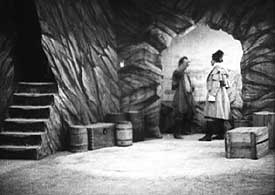 Kathleen Mavourneen (1906) is a thoroughly cliche melodrama inspired by a classic Irish ballad & the play it inspired, by Dion Boucicault.
Kathleen Mavourneen (1906) is a thoroughly cliche melodrama inspired by a classic Irish ballad & the play it inspired, by Dion Boucicault.
The film doesn't really tell the story clearly, but it was so familiar at the time that the directors seem to have felt it was unnecessary to explain anything that is happening, as audiences would already know the context & the characters' names. But this again opened the Edison company up to getting picked on by critics who would not fail to notice when more sophisticated films arose from newer companies.
Wealthy landlord & bad-guy Captain Clearfield (H. L. Bascom) has taken a lascivious interest in Kathleen (Kitty O'Neal), & hires the vile Dugan (W. R. Floyd) as his henchman to help intimidate Kathleen & her family.
The hireling pulls together a gang of Protestant rowdies & waylays Kathleen & her boyfriend Terrance (Walter Griswold) along the road, tormenting them at gunpoint before letting them go.
Clearfield manages to lay hands on the mortgaged deed to the house of Kathleen & her father (E. M. Leslie), but their fellow Catholics in the neighborhood fight off the villain when he arrives with local constables to evict the innocent family.
The film as it survives is incomplete & Clearfield & Dugan's kidnapping of Kathleen by chloriforming her is lacking, a scene known only by its contemporary catalog discription.
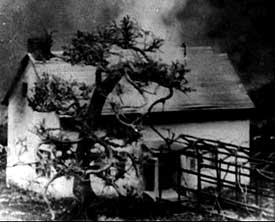 Clearfield's henchman Dugan burns down the family's cottage with the girl's father inside, but her father is saved by Terrance, though the house is lost. It's too bad this scene is lost, as only a still survives of the house burning, & it appears to have been done with quite a detailed miniature. Clearfield's henchman Dugan burns down the family's cottage with the girl's father inside, but her father is saved by Terrance, though the house is lost. It's too bad this scene is lost, as only a still survives of the house burning, & it appears to have been done with quite a detailed miniature.
The film picks up with Dugan & Clearfield carrying unconscious Kathleen away to the Protestant gang's secret cavern headquarters.
Having forgotten up to this moment to portray the Irish as a bunch of drunken micks & patties, there's at last a scene of an alcoholic hunched old woman caught by the evil Protestants boozing it up in the woods. They capture her & bring her to the cavern of vile Protestant rebels. Her big jug of whisky is confiscated so the gang can drink themselves blotto.
The old woman turns out to be Kathleen's boyfriend Terrance in disguise. When everyone's drunk he throws off his disguise & beats the Protestants into unconsciousness, saving the good Catholic Kathleen, taking her to an outdoor ho-down to do the jig. The hero & heroine then get married & god willing had fifteen Catholic babies.
This moronic film was a commercial success & would be remade a handful of times through the next three decades. A version starring Theda Bera was said to have caused theater riots because Irish were so incensed by their potrayal as people who riot; in consequence it was withdrawn from distribution.
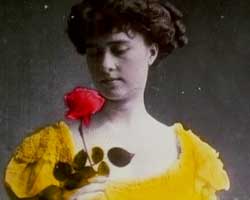 Three American Beauties (1906) was nearly always shown as a hand-tinted color film, & would be used by exhibitors as the closing short subject after a program otherwise of black & white films.
Three American Beauties (1906) was nearly always shown as a hand-tinted color film, & would be used by exhibitors as the closing short subject after a program otherwise of black & white films.
Because it was designed to be colored, it was restricted to under a minute, as hand coloring films was an expensive time consuming process. At the Edison Manufacturing Company, it was performed chiefly by the wives of company employees.
The first beauty is a rose which is in fact called "American Beauty" & to this day a garden standard. The second beauty is a woman holding the rose. Close ups of a rose, & of pretty women holding a rose, provided for easy & coloring opportunity.
The third beauty is the American flag blowing in the wind, in red white & blue. Ending exhibits with the flag would remain a tradition of many movie houses for decades to come, as also early television which went off the air each night with the American flag & patriotic band music.
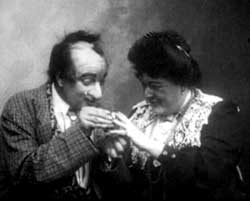 The urban Jewish milliner of Cohen's Fire Sale (1907) is a nasty stereotype wherein the comedian puts on a big false nose & bald cap & devotes himself with giddy avarice to making money.
The urban Jewish milliner of Cohen's Fire Sale (1907) is a nasty stereotype wherein the comedian puts on a big false nose & bald cap & devotes himself with giddy avarice to making money.
Of course the filmmakers would've alleged it to be a fondly conveyed stereotype with no harm intended, done only for the sake of comedy.
The character of Cohen appears in several films of the period, including another by Porter, the short-short Cohen's Advertising Scheme (1904). In the same grotesque make-up the money-grubbing Jewish shopkeeper lights upon a method of getting free advertising for his clothing store.
Pretending to possess a charitible nature, Cohen dupes a poor man into wearing a jacket which he does not realize has advertising on the back.
Cohen as universal Jew was not the creation of filmmakers. He was a stock character from the vaudeville stage, initially the creation of Jews themselves poking fun at themselves in Yiddish music halls.
In time the stereotypes became pervasive throughout the comedy industry so that in a film taken straight from the vaudeville stage, Levi & Cohen the Irish Comedians (1903), the archetypes are played by non-Jews for non-Jews & in the majority of the examples anti-Semitism is detectible.
Similarly the image of the shiftless slow-talking slow-walking negro originated on the chitlin circuit in black-for-black comedy entertainment. Unfortunately in both cases, these stereotypes had a different effect & meaning when enacted for audiences other than Jewish or African American respectively, as non-Jews loved to believe all Jews were big-nosed money-grubbers & all negroes were lazy & stupid.
Anti-semitic stereotypes would probably have reached the cinema without filmmakers consciously despising Jews, as they were merely borrowed wholesale from comedies & melodramas of the stage.
But in fact Edison was an anti-semite. He hated competition of any kind & usually went after his competitors with dubious business tactics, or made them an offer they couldn't refuse as when he absorbed the Biograph Company by giving J. Stuart Blackton the option of working for him or spending a good long time in the courts which Edison could more easily afford.
But to shut down the Jewish film arcades of the Lower East Side, he simply hired thugs to smash up their businesses. After he cornered the market for film stock, Jews like everyone else had to come to the Edison company for celluloid. And as a matter of company policy all Jews were turned away.
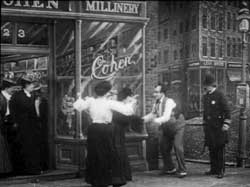 In Cohen's Fire Sale the stereotype is at first not as malicious as was often the case, & Cohen's response to the situation he finds himself in is the same as for any shop keeper, & so no reason to be so specific as to make him a Jew of Hester Street. But as the story progresses, his behavior becomes criminal. And for that, the prejudices of the filmmakers could only imagine it making sense if it was about Jews. In Cohen's Fire Sale the stereotype is at first not as malicious as was often the case, & Cohen's response to the situation he finds himself in is the same as for any shop keeper, & so no reason to be so specific as to make him a Jew of Hester Street. But as the story progresses, his behavior becomes criminal. And for that, the prejudices of the filmmakers could only imagine it making sense if it was about Jews.
He owns a milliner's shop in a New York business district on Hester Street. He has just received a shipment of hats from France & is unpacking them outside his store. The women in his family are arranging the first couple hats on display in the shop as he unpacks, & call for him to look at what they're doing.
While he's in the shop, the garbage man comes by & sees an open crate with some packing material scattered about. He picks up the scattered trash, stuffs it in the crate on top of the as yet unpacked imported hats, & hauls the crate away as trash.
Momentarily the milliner & his family fly into a panic over the costy loss which they assume to have been a theft.
Meanwhile the garbage wagon has lost part of its trash in a street where many children are playing. Soon all the little Jewish girls are wearing fancy hats & doing the Cake Walk round & round in the streets, quite a funny sequence really.
Cohen & his daughters come by with the police & reclaim the hats, more of which are being lost off the back of the garbage wagon.
A couple blocks further along Hester Street a group of young women & matrons are having a battle over possession of the hats that fell in their view. When Cohen arrives ahead of the others to reclaim his store's hats, the women beat him up.
The garbage cart arrives at the docks & backs up to the dock edge to dump the trash onto a barge, a setting previously celebrated in Edwin S. Porter's "actuality film" New York Dumping Warf (1903).
The garbage men on the barge whose job it is to even out the weight on the barge are soon hopping about in fancy hats, until Cohen & the police officer arrive to gather them up.
Perhaps because the hats were a bit bunged up from this escapade, they do not sell well, & Cohen is desparate for new sales. We see two interiors of his store, the front shop nicely decorated with hat displays, & his back room office.
A plan to make money on his fire insurance policy induces Cohen to tie a ribbon to the tail of one of his shop cats, the other end to a kerosene lantern, then leaving his shop for the cat to "cause" the fire.
Up to now Cohen has been a baffoon but no more avaricious than any shop owner who needs to turn a profit. But as a clever Jew, the stereotype demands worse.
The surprise to me is that even supposing prejudiced people found the idea of Jewish obsession with lucre just awfully funny, was it still funny to kill the cat in the name of greed? Was that regarded par for the course for Hester Street shop owners?
Special FX show quite a novel explosion that blows the cat out of existence while a smoking firebomb whirls round & round Cohen's hat shop.
The police officer detects the smoke, then there's a fire department "answering the alarm" sequence identical to scenes often filmed in such actuality films as Morning Alarm (1896). The shop is saved but the hats are water damaged & Cohen has a bang-up fire sale.
|
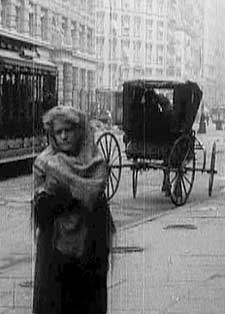

 That's not to say it's always easy to follow. It's a thirteen minute condensation of a stage melodrama, Hazel Kirke (1880), a sufficiently well known play that anyone who viewed the film adaptation would know the protagonist's name was Hazel.
That's not to say it's always easy to follow. It's a thirteen minute condensation of a stage melodrama, Hazel Kirke (1880), a sufficiently well known play that anyone who viewed the film adaptation would know the protagonist's name was Hazel. Weak from hunger, she nearly collapses, & has a vision of her father, or a memory of him, in what amounts to a "thought balloon," a trick to convey a character's interior life that Porter first used in
Weak from hunger, she nearly collapses, & has a vision of her father, or a memory of him, in what amounts to a "thought balloon," a trick to convey a character's interior life that Porter first used in 

 Clearfield's henchman Dugan burns down the family's cottage with the girl's father inside, but her father is saved by Terrance, though the house is lost. It's too bad this scene is lost, as only a still survives of the house burning, & it appears to have been done with quite a detailed miniature.
Clearfield's henchman Dugan burns down the family's cottage with the girl's father inside, but her father is saved by Terrance, though the house is lost. It's too bad this scene is lost, as only a still survives of the house burning, & it appears to have been done with quite a detailed miniature.

 In Cohen's Fire Sale the stereotype is at first not as malicious as was often the case, & Cohen's response to the situation he finds himself in is the same as for any shop keeper, & so no reason to be so specific as to make him a Jew of Hester Street. But as the story progresses, his behavior becomes criminal. And for that, the prejudices of the filmmakers could only imagine it making sense if it was about Jews.
In Cohen's Fire Sale the stereotype is at first not as malicious as was often the case, & Cohen's response to the situation he finds himself in is the same as for any shop keeper, & so no reason to be so specific as to make him a Jew of Hester Street. But as the story progresses, his behavior becomes criminal. And for that, the prejudices of the filmmakers could only imagine it making sense if it was about Jews.